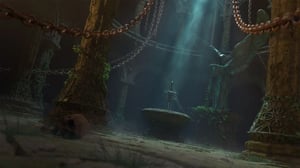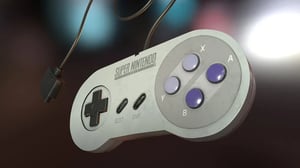
Game Artist
Student work by Yolac Yurekli
TABLE OF CONTENTS
What does a video game artist do?
A game artist is often a generalist animator and/or 3D modeler who creates both 2D and 3D art for video games. Working from design briefs and concept art, game artists give expression to the script from the storyboard to populate the world of the game.
They work on all the visual elements required to put a game together, including characters, objects, textures, assets, environments, props, vehicles, weapons, etc.
Many game artists will specialize in one or more of these areas as game development becomes increasingly sophisticated. The extent of the role also depends on the size of the studio and project.
During the course of their career they may take on a variety of positions within an animation and/or modeling or assets team, leading to an ever-increasing deeper understanding of the process.
Game artist job description
Game artists design preliminary sketches and develop them according to a video game’s general style. They then create 2D or 3D models from these sketches under the supervision of the Lead Artist. These elements create the world, its mood, and unique personality.
There are various areas of specialization for game artists, including character design, architecture and landscapes, lighting, modeling, special effects, texturing, and animation.
Role & responsibilities of a game artist in the gaming industry:
- Liaising with lead designers and developers regarding the style and feel of the game
- Researching references and resources required to produce the assets of the game
- Sketching concept designs and key elements of the visual style
- Building 3D models of all assets in line with the technical limits of the game engine
- Applying textures to all visual elements
- Adding lighting and shading effects to all elements, ensuring consistency in color, intensity and lighting levels
- Animating characters and creatures
- Integrating special effects to textures, scenes and events, including muzzle flashes, weather effects, particle systems, sparking wires, smoke, haze, billowing dust, steam vents, explosions, etc
- Creating sound effects, conducting audio mixes and design
- Designing promotional materials, packages, posters and websites for the launch of the game
- Producing prototypes for testing
- Working with motion capture
- Maintaining production documentation
- Advising on new technologies
- Problem solving both creative and technical issues
- Adhering to the production schedule
- Curating and cataloguing of the asset library
- Designing with the user experience in mind

How much does a game artist make?
The average salary of a game artist ranges from USD $69,000 to USD $124,000 depending on skills level and studio size. (Source: Glassdoor)
Skills required to become a video game artist
Game artists are skilled in many aspects of game development. As their careers progress they may specialize in an area that interests them most and serves their specific talents.
Games are produced by teams, so communication and interpersonal skills are vital to aid in the smooth running of the game production pipeline.
Video game studios may look for the following skills in game artists:
- Training in game art and animation
- Knowledge of lighting, perspective, material finishes and special effects
- Cinematic eye for lighting and shading
- Strong drawing skills, ability to visualize and design from abstract ideas
- Solid knowledge of game genres and latest trends in gaming
- Ability to work from storyboards
- Advanced understanding of visual language - texture, color, dimension, scale, perspective, shade, composition depth of field, proportion, spatial awareness, etc
- Talent for visual storytelling
- 3D modeling skills
- Knowledge of 2D and 3D animation, and familiarity with the principles of animation
- Systematic and logical work practices
- Working knowledge of industry standard software and ongoing professional development
- Team player, ability to work independently
- Experience in working with audio files
- Ability to create special effects
- Knowledge of anatomy, zoology, layout design, texturing and asset creation
- Ability to take on constructive criticism and delivering amendments based on feedback
- Used to working under pressure and consistently meeting deadlines
What software and tools do game artists use?
Game artists may work with any manner of gaming and animation software.
Game artists may need knowledge of a combination of the following software:

Maya is a comprehensive 3D animation software used for creating detailed models, animations, and visual effects. It's popular in film, TV, and game development for its powerful tools.

3ds Max is a professional 3D computer graphics program for making 3D animations, models, games and images. It is developed and produced by Autodesk Media and Entertainment.

MotionBuilder is a 3D character animation software produced by Autodesk. It is used for virtual cinematography, motion capture, and traditional keyframe animation.

Unreal Engine is a 3D computer graphics game engine developed by Epic Games, first showcased in the 1998 first-person shooter video game Unreal

Maxon ZBrush is a digital sculpting tool that combines 3D/2.5D modeling, texturing and painting

Unity is a cross-platform game engine developed by Unity Technologies, first announced and released in June 2005 at Apple Worldwide Developers Conference
How to become a game artist
Increase your chances of getting hired with these strategies for success:
Download software
Try free 3D modeling programs like Blender, ZBrushCoreMini, or Houdini Apprentice. Otherwise, Autodesk Maya (industry standard) offers a free trial.
Build skills
Build the skills companies are listing on job sites. For more support, enroll in a reputable course. CG Spectrum’s courses include mentorship from 3D modeling pros and an industry-led curriculum.
Watch trends
Online tutorials, webinars, and events can help keep your skills fresh.
Network
Networking is vital. Familiarize yourself with the industry and build your community. Interact online and in real life with industry pros who might offer advice, insights, or job opportunities.
Intern
Internships at VFX or game studios can help you break into the industry. It’s one way to gain hands-on experience, network, and experience studio life.
Sell assets
Create and sell assets on Unreal Engine Marketplace or similar to gain exposure, get feedback, demonstrate skills to potential employers and collaborators, and make money!
Collaborate
Know a rigger or animator who’d like to bring your model to life? Collaborating with peers is fun and can produce polished work for your reel.
Join contests
Practice your skills and create assets for your reel by participating in contests and challenges on sites like The Rookies, ArtStation, and 3Dtotal.
Specialize
Start building more of the assets you want to get hired to create—hard surface, organic, environments, creatures, characters, etc.
Share work
Social media is great for showcasing work, building an audience, having your work shared by others, and seen by potential clients and collaborators.

Ready to Start Your Film & Games Journey?
Download our course guide to see how we can help you on your pathway to your dream career.Tips to break into the industry as a game artist
Additional resources to help you get started as a 3D modeler for film and games:
- Read What is 3D modeling?
- Recommended reading list for 3D artists by CG Spectrum Mentor Bryan Mentor
- Check out Altruism Digital’s YouTube channel
- Watch How to sell your assets on Unreal Marketplace
- Download free assets on sites like Unreal Engine Marketplace, ProductionCrate, MegaScans,
AbientCG, Sketchfab, and TurboSquid and see how other people build their models - Use Anatomy for Sculptors’ free 3D écorché reference tool
- Join the Autodesk community and check out all their forums
- Blender also has a bunch of great communities you can join
- Explore ArtStation’s and 3Dtotal’s free modeling tutorials
- Visit the official Maya, ZBrush, and Houdini learning channels on YouTube
Demo reel tips:
- Tailor your reel to the studio and role you’re applying for
- Include scale reference to show your model is at the correct scale
- Where possible, show your model moving (e.g., via a turntable or rigged animation)
- If textured, render your model under different lighting conditions
- Use Vimeo for best video quality, plus you can update your video
- Embed your reel on a platform (like ArtStation) with high-res stills of your model’s best angles
- No studio experience: keep your reel < 1 min. 1–2 years experience: < 2 mins Work in progress is fine, but only include your best models
- Ensure music doesn’t distract from your work
- Double-check for errors; then check again
- Get feedback from at least 3 mentors or industry pros before finalizing
- Include reference footage, breakdowns, and credits where relevant
- Specify if your model is for animation, VFX, or games (each has different requirements)
- Share your reel on your website, ArtStation, LinkedIn, and other social channels
- Include any production experience

Industry Pathways
Bryan Bentley, 3D Modeling Curriculum Manager at CG Spectrum, shares how he broke into modeling almost by chance, from landing his first internship at the Jim Henson company to working at ILM on the Oscar-winning film Rango. Throughout, Bryan has nurtured his love for education and life-long learning.


